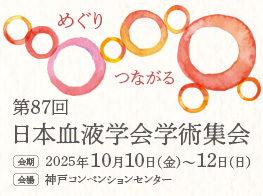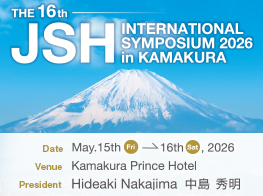
名前:佐藤 成【東京大学医科学研究所 細胞療法分野】
発表形式:Oral Presentation
Title:
CHIP-associated mutant ASXL1 activates innate immune pathway in myeloid cells and promotes atherosclerosis in mice
Authors:
Naru Sato1, Susumu Goyama2, Yu-Hsuan Chang1, Takeshi Fujino1, Shuhei Asada3, Shiori Shikata1, Xiaoxiao Liu2, Taishi Yonezawa2, Reina Takeda1, Keita Yamamoto1, Takuma Shibata4, Motohiro Sekiya5, Shuhei Koide6, Atsushi Iwama6, Kensuke Miyake4, Hitoshi Shimano5, Toshio Kitamura1
Affiliations:
1. Division of Cellular Therapy, Institute of Medical Science, The University of Tokyo, Bunkyo, Japan
2. Division of Molecular Oncology, Department of Computational Biology and Medical Sciences, Graduate School of Frontier Sciences, The University of Tokyo, Bunkyo, Japan
3. The Institute of Laboratory Animals, Tokyo Women’s Medical University, Shinjuku, Japan
4. Division of Infectious Genetics, Department of Microbiology and Immunology, University of Tokyo, Bunkyo, Japan
5. Department of Internal Medicine (Endocrinology and Metabolism), Faculty of Medicine, University of Tsukuba, Tsukuba, Japan
6. Division of Stem Cell and Molecular Medicine, Center for Stem Cell Biology and Regenerative Medicine, Institute of Medical Science, The University of Tokyo, Bunkyo, Japan
Abstract:
Background: Recent epidemiological studies showed the significant association between cardiovascular diseases (CVD) and clonal hematopoiesis of indeterminate potential (CHIP). CHIP is defined as the clonal expansion of blood cells driven by somatic mutations in hematopoietic genes, such as DNMT3A, ASXL1, TET2, or JAK2. Previous studies have shown that TET2-, DNMT3A- and JAK2-driven CHIP in fact pro- mote atherosclerosis or worsen heart failure using mice models. In contrast, whether and how ASXL1 mutations contribute to atherosclerosis remains unknown despite the robust clinical association between mutant ASXL1-driven CHIP and CVD.
Aims: We aim to investigate the crosstalk between hematopoiesis with mutant ASXL1 and CVDs.
Methods: We previously established knockin (KI) mice expressing a C-terminally truncated form of ASXL1-mutant (ASXL1-MT). Using these mice, we assessed if the high-fat diet (HFD) affects the reconstitution and differentiation of hematopoietic cells with ASXL1-MT. We also assessed the role of hematopoietic cells derived from ASXL1-MT KI mice in the development of atherosclerotic CVDs using the atherosclerosis-prone Ldlr-/- mice. To study the mechanisms underlying the promotive effect of ASXL1 mutation on atherosclerosis, we used mouse and human cell lines (RAW264.7 cells, 293T cells), BaF/3 cells expressing Toll-like receptor (TLR), and bone marrow-derived macrophages derived from the ASXL1-MT KI mice.
Results: The Ldlr-/- mice transplanted with bone marrow from ASXL1-MT KI mice showed significantly larger atherosclerotic lesions in the aorta and aortic valves than the control mice. We also found that HFD conferred growth advantage to ASXL1-MT cells over wild-type cells, particularly in the population of the inflammatory monocytes. Consistent with these findings, RNA-seq of the plaque-macrophages derived from ASXL1-MT KI mice showed more inflammatory signatures than those from control mice. Thus, these data suggest that mutant ASXL1 promotes HFD-induced expansion of inflammatory monocytes and macrophages, thereby accelerates atherosclerosis.
Mechanistically, we found that wild-type and mutant ASXL1 have different effects on the innate immune pathway. NF-κB reporter assay revealed that wild-type ASXL1 suppressed, while mutant ASXL1 promoted, the reporter activation induced by the TLR stimulation. Furthermore, we found that wild-type ASXL1, but not mutant ASXL1, suppresses the activation of TAK1 in TLR-NF-κB signaling pathway through direct interaction with IRAK1 and TRAF6. These results suggest that ASXL1 inhibits the innate immune pathway through interactions with IRAK1/ TRAF6/TAK1 in myeloid cells, while mutant ASXL1 loses this regulatory function. Finally, we assessed the effect of IRAK1/4 inhibitor on atherosclerosis in HFD-fed ASXL1-MT mice. As expected, IRAK1/4 inhibition decreased the number of inflammatory monocytes and attenuated the development of atherosclerosis driven by ASXL1-MT.
Summary/Conclusion: Our study demonstrated the causative role of the CHIP-associated ASXL1 mutation to promote atherosclerosis. Inhibition of the innate immune pathway may prevent the development of CVD associated with CHIP harboring ASXL1 mutations.
The EHA2021 受賞レポート
この度はEuropean Hematology Association (EHA) 2021 Virtual Congressでの発表にあたり、JSH Abstract Achievement Award for The EHA2021に選出いただき、誠にありがとうございました。おかげさまで今回Oral sessionに採択され、またEHAからYoungEHA Best Abstract Awardという大変栄誉ある賞までいただき、誠に光栄に存じます。
今回のEHAは新型コロナウイルスの感染拡大によって、2021年6月9日から17日までオンラインでの開催となりました。本来ならばオーストリアのウィーンでの開催予定で、現地の雰囲気が味わえないのは少し残念でしたが、最新の知見が集まる国際学会に自宅や職場から参加できることの利便性や、質疑応答のしやすさなど、オンライン開催の良い面も感じました。
私は今回、クローン性造血で高頻度に見られるASXL1遺伝子の異常と動脈硬化症との関連について、マウスモデルを用いた解析の結果を報告いたしました。近年の次世代シーケンサーを用いた網羅的解析により、血液検査で異常のない健常人末梢血において、加齢に伴って体細胞変異が増加することが明らかとなり、この現象はクローン性造血(CHIP)と呼ばれています。CHIPは血液腫瘍発症リスクのみならず、心筋梗塞や脳卒中などの心血管疾患発症に関連することが判明し、注目を集めています。ASXL1はCHIPで最も多い遺伝子異常の一つですが、心血管疾患にどのように関与するのか、その詳細はわかっていませんでした。我々は変異型ASXL1を造血器特異的に発現するノックインマウスの骨髄を、動脈硬化モデルマウスへ移植することにより、ASXL1変異が炎症性単球の増加とマクロファージにおける炎症性の亢進を介して、動脈硬化症を促進することを明らかにしました。驚くべきことに、ASXL1は炎症性シグナル伝達経路の主要因子であるIRAK1、TRAF6、TAK1に直接結合し、過剰な活性化を抑制しており、そして変異型ASXL1はこの制御機能を失っていることも明らかとなりました。またIRAK1/4阻害剤を投与することで、変異型ASXL1ノックインマウス由来骨髄を移植したマウスの動脈硬化病変が縮小したことから、CANTOS試験で示された抗IL-1β抗体による心疾患イベントの抑制のように、今後CHIP保有動脈硬化症患者において、自然免疫経路の抑制療法が新規治療法として期待されます。
私はEHAのような国際学会での口頭発表は、今回が初めての経験でした。事前録画での発表でしたが、EHAの技術者の方とオンラインでやりとりしながらの録画も緊張しましたし、6月14日に行われたLive Q&A sessionでは1分間1スライドでのフラッシュトーク後に5分間の質疑応答を行ったのち、パネルディスカッションとして聴衆や司会の方々からの質問にリアルタイムで答えるなど、上手く話せず悔やむこともありましたが、大変有意義な体験となりました。なお他の方の発表でも見られましたが、ネットワーク環境やブラウザの不備によるトラブルが散見され、基本的なことですが有線での接続や事前のPC設定の確認に加え、一度は本番と同じ環境で予行演習を行うことが重要だと思いました。
Virtual Congressではオンデマンドで約2ヶ月間、教育講演のほかライブで見逃したシンポジウムも見ることができ、全体として得られる情報は現地開催よりも多いかもしれません。またEHAでは研究者・医師のキャリア形成について先輩研究者やPIが自身の経験を振り返りながら講演するセッションなどもあり、学会全体として若手の教育を重視している印象を受けました。
最後に、今回このような機会を与えてくださった日本血液学会事務局、国際委員の諸先生に心より御礼申し上げます。また日頃よりご指導いただいております北村俊雄教授、合山進教授、本研究に携わっていただいた当研究室ならびに共同研究先の皆様に、この場を借りて厚く御礼申し上げます。



